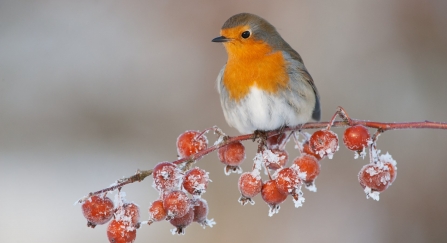
Our top 10 wildlife sightings for December
Starling murmuration by Phill Luckhurst/distinctlyaverage

Robin
Robins become prominent in our gardens in winter, and on many Christmas cards and decorations!
They are usually territorial, but become more so as it gets colder. They mark their territory both by singing and posturing to rivals. If this behaviour doesn’t put off the intruder, you might see a fight lasting anything from a few seconds to over an hour!
They're one of the few birds that sing all year round and you might hear them at night singing away near street lights.

Starling murmurations
Starlings form large flocks in winter as British birds are joined by others from the continent. They roost together in huge flocks and as they gather at dusk they can form huge murmurations.
Watching a murmuration of starlings wheeling and whirling across the sky is one of winter's highlights. In our area Thatcham Reeedbeds can be a good place to spot starlings as they gather at dusk before roosting.
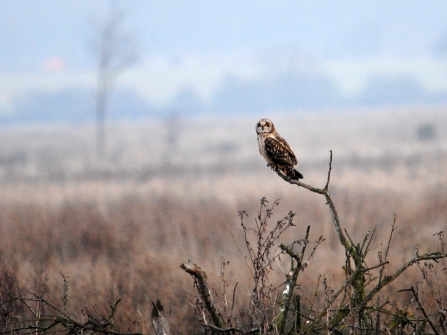
A short-eared owl perched on a branch at winter. Picture: Amy Lewis
Short-eared owl
Unlike many species of owl, you may see short-eared owls hunting during the day as well as at dusk.
In the winter, our resident birds are joined by more from the continent. Look out for them hunting small mammals, and occasionally small birds, over wetlands and marshy grassland such as Chimney Meadows and the Upper Ray Meadows.
They have piercing yellow eyes and streaky feathers that camouflage them well against the grassland. Their 'ears' are actually tufts of feathers.

Pied wagtails
Pied wagtails are very distinctive as they walk along the ground wagging their tails while searching for food.
At dusk in winter they gather in large flocks to roost. You can often see this in urban areas where they may roost in trees near offices and shops so look carefully if you hear lots of birds twittering overhead.
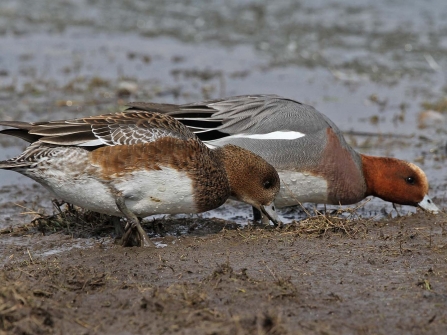
Wigeon
Look for 'whistling' wigeon on lakes, reservoirs and rivers and listen out for their distinctive whistling call. The males have a bold orange stripe along their heads while the females have a browner head and back. They eat vegetation and are often seen feeding on damp, marshy areas next to rivers and lakes.
Get started identifying different ducks and geese at College Lake, where you can ask reserve staff for help to tell them apart.
You can learn more about the difference between 'divers and dabblers' in our blog.
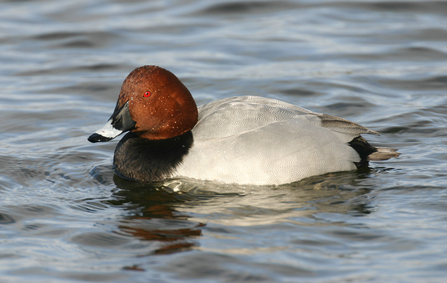
Male pochard by Tom Marshall
Pochard
A small number of pochard live in the UK all year round but you will see many more during the winter when the numbers increase as birds arrive from the continent. The males are very distinctive with their chestnut heads.
College Lake is one of the best sites to see a whole range of wintering birds in the Buckinghamshire. There are many bird hides overlooking the lake and a circular walk to explore the whole site.
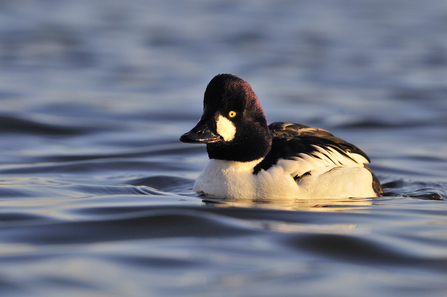
Male goldeneye by Fergus Gill/2020VIsion
Goldeneye
These distinctive ducks are seen on large lakes and rivers during the winter months. The population increases in winter due to migrants from the continent but they don't tend to gather in large numbers. Keep an eye out for them at places like Hosehill Lake and Calvert Jubilee, you never know when you might spot one in amongst the other birds.
Did you know goldeneyes nest in cavities in trees so their chicks have to perform a great leap of faith the day after hatching to leave the nest and reach the ground!
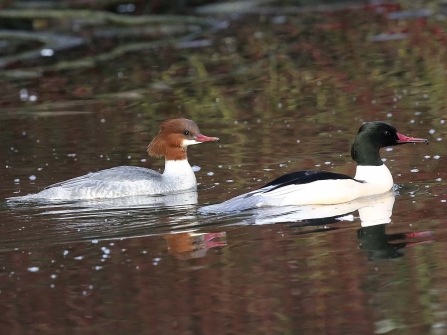
Goosanders by Margaret Holland
Goosander
Goosander catch fish such as trout and salmon with their long, serrated bills. These large ducks are part of the sawbill family. Their scientific name, Mergus merganser, roughly translates as 'plunging goose' as they dive down into the water to hunt for fish.
Calvert Jubilee and Foxcote Reservoir are great places to look for a whole range of water birds during the winter months.
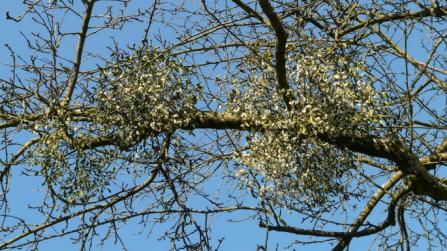
Mistletoe
Round clumps of mistletoe silhouetted against the sky are an iconic winter sight, and, of course, a festive essential. If you can get close enough, check whether you’re actually looking at mistletoe or a witches broom, which is actually a type of gall!
Mistletoe is highly poisonous, but you might see mistle thrushes, fieldfares and blackcaps eating the white berries, as they have evolved to cope with its toxic effect. The seeds are coated with a sticky substance called viscin which glues them to the branches, ready to germinate around April.
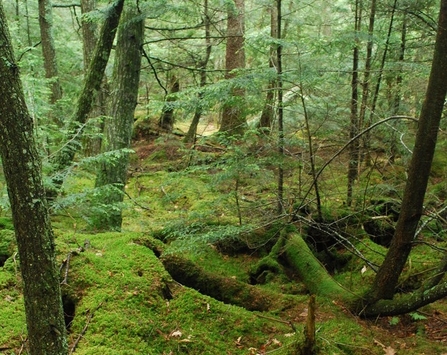
Sphagnum moss on forest floor by wackybadger CC BY-SA 2.0
Mosses and lichens
With the leaves on the trees long gone, it’s easier to notice the tiny world of mosses and lichens. It’s well worth taking along a hand lens on a walk to get a closer look!
Mosses can have some amazingly descriptive names. Species to look out for include for silky forklet moss, marsh hair moss and sphagnum moss, which can be found on Wildmoor Heath.
If you're looking for something to add to your Christmas list, check out this wonderful book-length guide to finding mosses in our three counties.
Stay up-to-date with our work
Sign up below to receive the latest news from BBOWT, tips about how you can help wildlife, plus information on how you can get involved.

